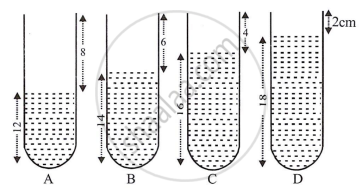Advertisements
Advertisements
Question
In following figure shows A, B , C and D represent test tube each of height 20 cm which are filled with water up to heights of 12 cm, 14 cm, 16cm and 18cm respectively. If a vibrating tuning fork is placed over the mouth if test tube D, a loud sound is heard.

- Describe the observations with the tubes A, B and C when the vibrating tuning fork is placed over the mouth of these tubes.
- Give the reason for your observation in each case.
- State the principle illustrated by the above experiment.
Solution
- No loud sound is heard with the tubes A and C, but a loud sound is heard with the tube B.

- While tubes A and C do not experience resonance with their air columns, tube B does. The air column length in tube D is 20 – 18 = 2 cm, while in tube B it is 20 – 14 = 6 cm, which is three times the length in tube D. Consequently, the frequency of vibrations in both tubes is identical. Contrarily, air column vibrations in tubes A and C do not have the same frequency as those in tube B.
- Resonance happens when the air column vibration frequency is exactly the same as the tuning fork vibration frequency.
APPEARS IN
RELATED QUESTIONS
In the diagram below, A, B, C, D are four pendulums suspended from the same elastic string PQ. The length of A and C are equal to each other while the length of pendulum B is smaller than that of D. Pendulum A is set into a mode of vibrations

1) Name the type of vibrations taking place in pendulums B and D?
2) What is the state of pendulum C?
3) State the reason for the type of vibrations in pendulum B and C.
Why is a loud sound heard at resonance?
Why are the stringed instruments like guitar provided with a hollow sound box?
(i) Define resonant vibrations.
(ii) Which characteristic of sound, makes it possible to recognize a person by his voice without seeing him?
Differentiate between the following:
Free and forced vibrations.
A bucket kept under a running tap is getting filled with water. A person sitting at a distance is able to get an idea when the bucket is about to be filled.
(i) What change takes place in the sound to give this idea?
(ii) What causes the change in the sound?
When a tuning fork, struck by a rubber pad, is held over a length of the air column in a tube, it produces a loud sound for a fixed length of the air column. Name the above phenomenon. How does the frequency of the loud sound compare with that of the tuning fork? State the unit for measuring loudness.
A string stretched between its ends is made to vibrate by placing the stem of a vibrating tuning fork at its one end. State three ways how you will increase the frequency of note produced by the string.
Describe a simple experiment to illustrate the phenomenon of resonance and explain it.
